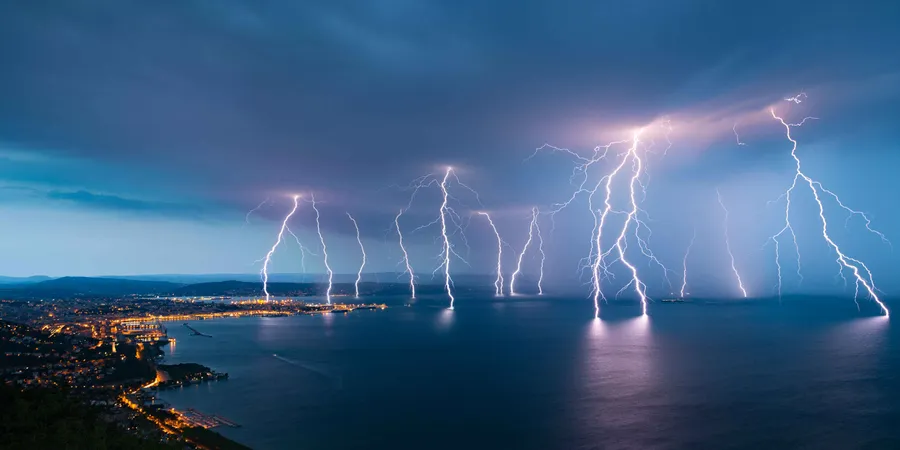
Lead supervisor: Nathan Luke Abraham, Chemistry
Co-supervisors: Alex Archibald, Chemistry; Maria Russo, Chemistry; Fiona O'Connor, UK Met Office
Brief summary:
Lightning strikes produce highly reactive nitrogen oxide (NO) which has the potential to alter the global ozone budget and its radiative forcing: this work will investigate the representation of lightning in the UK Earth System Model (UKESM) and its impact on current and future climate.
Importance of the area of research concerned:
Lightning is a natural process initiated by convection and the presence of clouds. The location and frequency of lightning strikes is important as they are a major cause of wildfires in remote locations. Furthermore, lightning produces highly reactive nitrogen oxide (NO); in a clean tropical environment, NO can contribute to the formation of tropospheric ozone (a greenhouse gas and pollutant) and can also reduce concentrations of the hydroxyl radical (which cleans the air from volatile organic compounds and other pollutants).
Although NO from lightning is only a small fraction of total NO emissions, it has a disproportionately large influence on the tropospheric ozone budget. It has been estimated that NO from lightning contributes around 50% of ozone in the tropical upper troposphere (Lelieveld and Dentener, 2000). More recently, the lightning parameterisation in UKESM was found to be responsible for large model biases compared to satellite data (Russo et al., 2023).
Lightning has the potential to influence climate through chemistry-climate interactions and despite previous attempts (Luhar et al. 2021) the correct representation of lightning in UKESM is still an open challenge.
Project summary :
This work aims to understand and improve lightning parameterisation in UKESM and assess its impact on climate. First, we will use a number of observational products to evaluate how well different parameterisation schemes in UKESM represent lightning in the recent past and present day period. Satellite data will provide useful information on ozone concentrations and lightning flash frequency on the global scale. Additionally, we will use a newly developed database with a decade of NO and ozone measurements from the NERC ‘Facility for Airborne Atmospheric Measurements’ (FAAM) research aircraft.
Following this initial assessment, climate simulations will be performed using different possible future scenarios to evaluate the impact of different lightning parameterization schemes on future climate through chemistry climate feedbacks.
What will the student do?:
The student will run and analyse data from UKESM simulations, with the aim of improving the representation of lightning in UKESM and understanding its climate impact.
The student will initially perform a review of existing lightning parameterisations schemes and test their performance within the UKESM framework. Improvement to existing parameterisation schemes will be investigated, as well as developing and implementing new lightning parameterisation schemes as required. Results from the model simulations will be evaluated against a variety of observational data using well established statistical techniques.
Following the evaluation of lightning parameterisation schemes, the student will perform and analyse future climate simulations with UKESM.
The student will also be encouraged to get involved with hands-on measurements of NO on board of the FAAM aircraft. Working closely with FAAM scientists the student will investigate past and present NO measurements from the FAAM dataset to find how lightning impacts NO in the tropical upper troposphere.
Fortran and Python languages will be used to implement changes to the UKESM code and to analyse data.
References - references should provide further reading about the project:
Lelieveld, J. & Dentener, F. J. 2000. What controls tropospheric ozone? J. Geophys. Res.-Atmos., vol. 105, pp.3531–3551, https://doi.org/10.1029/1999jd901011
Luhar, A. K., Galbally, I. E., Woodhouse, M. T., and Abraham, N. L. 2021. Assessing and improving cloud-height-based parameterisations of global lightning flash rate, and their impact on lightning-produced NOx and tropospheric composition in a chemistry–climate model. Atmos. Chem. Phys., vol. 21, pp.7053–7082, https://doi.org/10.5194/acp-21-7053-2021
Russo, M. R., Kerridge, B. J., Abraham, N. L., Keeble, J., Latter, B. G., Siddans, R., Weber, J., Griffiths, P. T., Pyle, J. A., and Archibald, A. T. 2023. Seasonal, interannual and decadal variability of tropospheric ozone in the North Atlantic: comparison of UM-UKCA and remote sensing observations for 2005–2018. Atmos. Chem. Phys.,vol. 23, pp.6169–6196, https://doi.org/10.5194/acp-23-6169-2023
Applying
You can find out about applying for this project on the Department of Chemistry page.